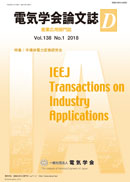Volume 138, Issue 2
Displaying 1-28 of 28 articles from this issue
- |<
- <
- 1
- >
- >|
Special Issue on “J-RAIL 2016”
Special Issue Paper
-
2018Volume 138Issue 2 Pages 69-75
Published: February 01, 2018
Released on J-STAGE: February 01, 2018
Download PDF (2070K) -
2018Volume 138Issue 2 Pages 76-83
Published: February 01, 2018
Released on J-STAGE: February 01, 2018
Download PDF (1247K) -
2018Volume 138Issue 2 Pages 84-90
Published: February 01, 2018
Released on J-STAGE: February 01, 2018
Download PDF (1258K) -
2018Volume 138Issue 2 Pages 91-98
Published: February 01, 2018
Released on J-STAGE: February 01, 2018
Download PDF (1233K) -
2018Volume 138Issue 2 Pages 99-104
Published: February 01, 2018
Released on J-STAGE: February 01, 2018
Download PDF (990K) -
2018Volume 138Issue 2 Pages 105-112
Published: February 01, 2018
Released on J-STAGE: February 01, 2018
Download PDF (1654K)
Paper
-
2018Volume 138Issue 2 Pages 113-121
Published: February 01, 2018
Released on J-STAGE: February 01, 2018
Download PDF (3021K) -
2018Volume 138Issue 2 Pages 122-127
Published: February 01, 2018
Released on J-STAGE: February 01, 2018
Download PDF (1569K) -
2018Volume 138Issue 2 Pages 128-134
Published: February 01, 2018
Released on J-STAGE: February 01, 2018
Download PDF (2538K) -
2018Volume 138Issue 2 Pages 135-140
Published: February 01, 2018
Released on J-STAGE: February 01, 2018
Download PDF (1093K) -
2018Volume 138Issue 2 Pages 141-149
Published: February 01, 2018
Released on J-STAGE: February 01, 2018
Download PDF (3501K) -
2018Volume 138Issue 2 Pages 150-163
Published: February 01, 2018
Released on J-STAGE: February 01, 2018
Download PDF (2588K) -
2018Volume 138Issue 2 Pages 164-172
Published: February 01, 2018
Released on J-STAGE: February 01, 2018
Download PDF (2692K)
News Letter
-
2018Volume 138Issue 2 Pages NL2_1
Published: February 01, 2018
Released on J-STAGE: February 01, 2018
Download PDF (938K) -
2018 IEE-Japan Industry Applications Society Conference —Conference Information and Call for Papers—2018Volume 138Issue 2 Pages NL2_2-NL2_3
Published: January 01, 2018
Released on J-STAGE: February 01, 2018
Download PDF (1457K) -
2018Volume 138Issue 2 Pages NL2_4-NL2_6
Published: February 01, 2018
Released on J-STAGE: February 01, 2018
Download PDF (897K) -
2018Volume 138Issue 2 Pages NL2_7
Published: February 01, 2018
Released on J-STAGE: February 01, 2018
Download PDF (993K) -
2018Volume 138Issue 2 Pages NL2_8
Published: February 01, 2018
Released on J-STAGE: February 01, 2018
Download PDF (882K) -
2018Volume 138Issue 2 Pages NL2_9-NL2_16
Published: February 01, 2018
Released on J-STAGE: February 01, 2018
Download PDF (5406K) -
2018Volume 138Issue 2 Pages NL2_17
Published: February 01, 2018
Released on J-STAGE: February 01, 2018
Download PDF (1706K) -
2018Volume 138Issue 2 Pages NL2_18
Published: February 01, 2018
Released on J-STAGE: February 01, 2018
Download PDF (1023K) -
2018Volume 138Issue 2 Pages NL2_19
Published: February 01, 2018
Released on J-STAGE: February 01, 2018
Download PDF (2687K) -
2018Volume 138Issue 2 Pages NL2_20
Published: February 01, 2018
Released on J-STAGE: February 01, 2018
Download PDF (906K) -
2018Volume 138Issue 2 Pages NL2_21
Published: February 01, 2018
Released on J-STAGE: February 01, 2018
Download PDF (977K) -
2018Volume 138Issue 2 Pages NL2_22
Published: February 01, 2018
Released on J-STAGE: February 01, 2018
Download PDF (1390K) -
2018Volume 138Issue 2 Pages NL2_23
Published: February 01, 2018
Released on J-STAGE: February 01, 2018
Download PDF (881K) -
2018Volume 138Issue 2 Pages NL2_24
Published: February 01, 2018
Released on J-STAGE: February 01, 2018
Download PDF (880K)
-
2018Volume 138Issue 2 Pages L2_1-L2_2
Published: February 01, 2018
Released on J-STAGE: February 01, 2018
Download PDF (839K)
- |<
- <
- 1
- >
- >|
